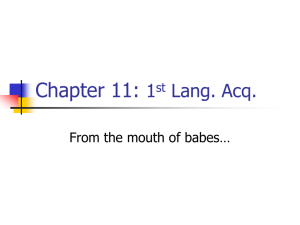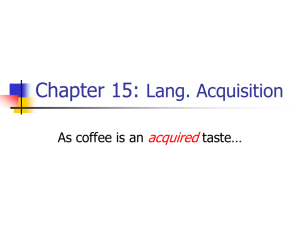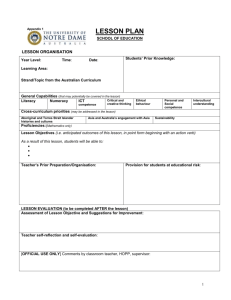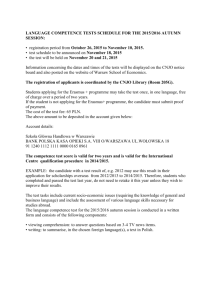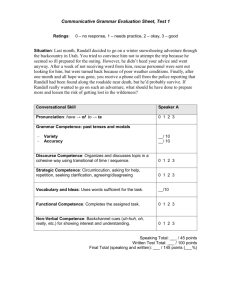Prove or Disprove… - USC Upstate: Faculty
advertisement
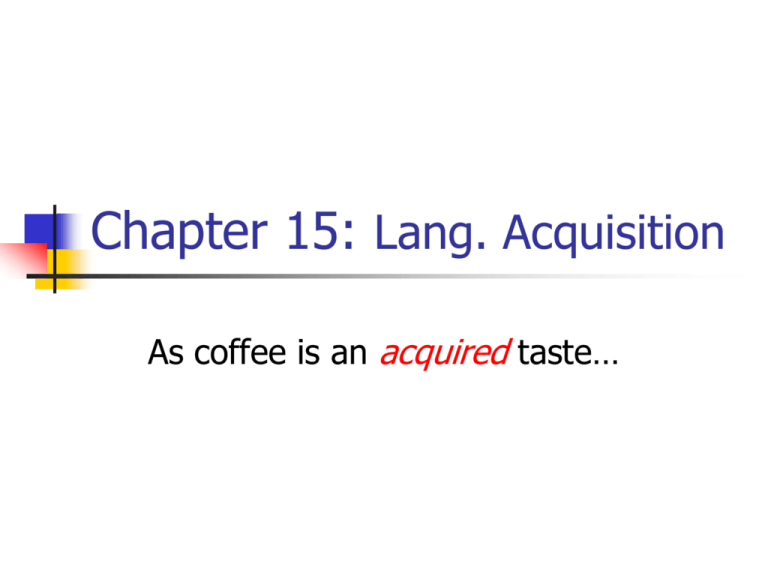
Chapter 15: Lang. Acquisition As coffee is an acquired taste… KidSpeak… Other examples of “KidSpeak”? FLA: More than Imitation To learn one’s first language: Learn words Recognize relationships Derivational & Inflectional morphemes Sentence order Word collocations Semantics Pragmatics Make generalizations The Enablers Innate Grammar Motherese Cognitive Development Feedback No genetic predisposition… You catch more flies with honey… Recasting Critical period Syntax One-Word Stage Two-Word Stage Telegraphic Stage Movement Rules Y/N Questions WH Questions Passive Reflexive & Pronouns Morphology Kids Acquisition 1. (abbreviated) -ing the, a 2. -ing 1. plural -s 3. possessive -’s 2. 4. Parents Usage the, a 3. 4. past tense -ed 6. 3rd pers. sing. -s 7. auxillary BE 5. So what…? 5. 6. 7. plural -s auxillary BE possessive -’s 3rd pers. sing. –s past tense -ed Morphology Kids Acquisition -ing plural -s possessive -’s the, a past tense -ed 3rd pers. sing. -s auxillary BE Question: Would you expect exactly the same order in Spanish, German & Chinese kids? (Ex. 9) Lexicon: Common 1st Words Daddy, mommy, baby… Juice, milk, cookie, water, apple… Dog, cat, duck, horse… Car, boat… Shoes, hat… Ball, blocks… Bottle, key… Hot, all-gone, dirty, cold, here, there… Up, sit, see, eat, go, down… Hi, bye… Whaddya think: Why these words….? Morphological Acquisition Phrase final elements Syllabicity Intolerance of Ambiguity ≠ Homophony ≠ Exceptional ≠ Allophonic = Clear Semantics The Ways We Learn (& Err) Whole Object Assumption Type Assumption Basic Similarities Assumption Overextension Underextension Verb meanings Dimensions Any Questions… …before we move on? (next: Phonology) Phonological Development She said “da-da” Babbling Put one foot in front of the other… Vowels Stops Labials Word-initial Reception before “ “ “ “ Consonants Fricatives/Affricates Velars Word-final Production Early Phonetic Production Substituted segments Deleted syllables Deleted final consonant Reduced consonant clusters More Examples? Get Some Exercise What phonetic processes are evident in the pronunciation of a 2 yr old below? pocket spoon zoo bath grandma [bα] [bun] [du] [bæt] [gαgα] What might we hear for: juice under From Previous Slide: Substituted segment Deleted syllables Deleted final consonant Reduced consonant clusters KidSpeak… Linguistically Realistic? Any Questions… …before we move on? (next: Researching) Foundations Innate grammar Methods Naturalistic We’re taking the video anyway… Longitudinal Experimental Focused on a point Cross-sectional Wug Test One Wug Two _____ Get Some Exercise One Naturalistic study found only 12 of 60 children used a passive structure. (2) Does this mean the other 48 had not yet acquired the passive structure? How does this example reflect on the “pros & cons” of the Naturalistic approach? Other Pros/Cons to Naturalistic/Behavioral Approaches? Any Questions… …before we move on? (next: Second Language Acquistion) “Gina is by lingual… that means she can say the same thing twice, but you can only understand it once.” Comparing FLA & SLA FLA SLA Blank slate Intensive input Adaptability Competition Peripheral input Less flexible Reduced cognition Less experience Expanded cognition More Experience Motivation Matters Instrumental Goal oriented Integrative Community based Whaddya Think? Acquiring a second language involves both KNOWING something about the language and BEING ABLE TO DO SOMETHING with the language. How do you think that knowledge and skills are related? What is an acceptable trade-off between accuracy and fluency? Competence & Performance L2 L1 Interlanguage Interlanguage Transference L1 competence in L2 performance Pre-nominal ADJs in Spanish of English native “e” b/4 initial ‘sk’ in English of Spanish native Fossilization Interlanguage ‘errors’ become ‘rules’ Will I (they) Ever Get It? Age Critical Period Hypothesis Idiosyncrasies Affective issues Cognitive issues cf. Krashen’s Filter Positive (Direct) Evidence Negative (Indirect) Evidence Learning environment Whenever we speak… Language Competence Organizational Competence Grammatical Competence Vocabulary Strategic Competence Pragmatic Competence Textual Competence Cohesion Illocutionary Competence Rhetorical Organization Dialect Syntax Morphology Phonology Typical Language Instruction Sociolinguistic Competence Functional Abilities Cultural References Register Interlanguage Phonology Markedness Differential Hypothesis Similarity Differential Rate Hypothesis Linguistic universals ~ If it’s uncommon, it’ll be harder to acquire Similarity breeds confusion… Syllabification Once a syllable, always a syllable… A stressful situation Exercise A dialect of Arabic breaks up clusters by inserting an epenthetic vowel in front of an unsyllabified consonant. How would a speaker of this dialect pronounce the following words? plant transport translate Exercise (some more) Given what you know about implicational universals, do you think it would be easier for an English speaker to acquire French nasal vowels (e.g. gant [gã] ‘glove’) or for a French speaker to acquire English oral vowels? Exercise (again) What explanation would you give for a native speaker of French who produced the English sentence ‘I drink frequently coffee’ ? How could you explain to this person that ‘He is frequently late’ is grammatical? Do any other English verbs have the same properties as BE ? Interlanguage Morphology L1 Acquisition -ing plural –s irregular past possessive -’s copula (main verb) BE articles the, a, an regular past -ed 3rd pers. sing. -s auxillary BE L2 Acquisition -ing copula (main verb) BE articles the, a auxillary BE plural -s irregular past regular past -ed 3rd pers. sing. –s possessive -’s Morphology Exercise Second language learners, regardless of their first language, produce forms like goed, sheeps, and could decided even though they never hear these from a native speaker. Why? What are some other forms you might expect to hear? Bilingualism L2 L1 (w/ & w/o Fossilization) Bilingual production L½ L1 Persistent Errors Fossilization: Whaddya think? What factors influence fossilization? What might make some people more likely to fossilize than others? Can fossilization be reversed? If no: why not? If yes: Under what circumstances? What strategies might be most effective? In the Classroom Modified Input Teacher talk ( i +1) Modified Interaction Discourse differences Focus on Form Explicit Language Instruction Error Correction Self-monitoring & correction Bilingual Education Almost 10% of school kids = ESoL Bilingual Education English-Only ESL Newcomer Programs Heritage Language Programs Over 500% increase ESoL kids in SC from 1994 - 2004 Education: Whaddya think? Roughly 75% of all non-native speakers of English in K-12 schools will drop out by or before the 10th grade. What SLA issues share in this issue? What can we do about it?
